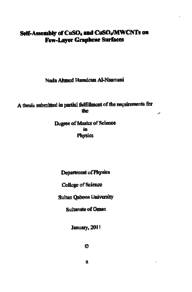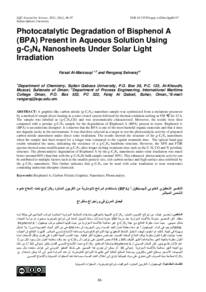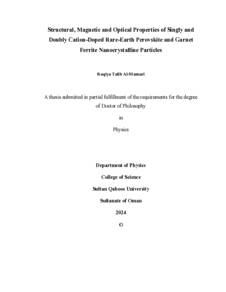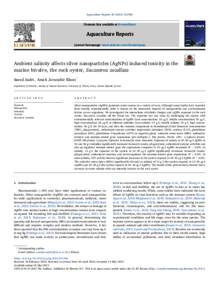وثيقة
Self-assembly of CuSO4 and CuSO4/MWCNTs on few-layer graphene surfaces
الناشر
Sultan Qaboos University
ميلادي
2011
اللغة
الأنجليزية
الملخص الإنجليزي
Self-assembly of CuSO4 and MWCNTs have been studied using TEM and AFM techniques together with Monte Carlo simulations based on Ising lattice gas model. The prepared samples of CuSO4 nano-platelets were found to have hexagonal structure. Upon addition of MWCNTs, the Cuso nano-platelets agglomerated and formed fractal structures which were phase separated from MWCNTs. Dip coating of CuSO, nano-platelets on FLG surfaces consistently revealed the formation of dual scale and nano bubble structures. In contrast to what is known, it is observed that nano-bubbles are formed on an ultra-thin dewetted layer of SA thickness graphene and exhibit unusual stability at ultra high vacuum conditions. Further nano-bubble rings were observed at atmospheric pressure. The results provide direct experimental evidence of interaction between MWCNTs and nano-bubbles at air-liquid-solid triple contact line and at lower step edge of the FLG which effect the alignment of MWCNTs. Due to the balancing of surface tension forces and strain forces arising from tube bending the tubes attained straight rod-like shape which enables accurate evaluation of elastic modulus E= 0.9 TPa. Due to the lower mobility of CuSO4 nanoplatelets, fingering instabilities on the rims were generated as the holes in the deposited film grew. These fingering instabilities agree well with those generated from simulations. Finally, fractal formation effected the solvent evaporation and led to the reduction of hole formation. This was associated with observation of trapping and bending of MWCNTs by the contact line. Depending on the bending degree, different structures such as rings and hooks shapes were formed. The evaluation of the spring constant K for the bent MWCNT was found to be 0.1 N/m well below the critical stiffness of 1-5 N/m required to prevent the tube bending, thereby, justifying the bending of MWCNTs by the contact line.
المجموعة
URL المصدر
الملخص العربي
في هذا البحث تم دراسة التجمع الذاتي لكبريتات النحاس و كبريتات النحاس مع انابيب الكربون متعددة الجدران بحجم النانو بإستخدام تقنية المجهر الإلكتروني المرسل و تقنية المجهر القوى الذرية و محاكاة مونت كارلو المعتمدة على نظرية ايزنج اللغز. لقد وجد أن عينات كبريتات النحل المحضرة تملك شكل سداسي البنية و بعد إضافة أنابيب الكربون متعددة الجدران بحجم الثاني إلى المحلول المحتوي على كبريتات النحاس. ظهر تجمع لجزيئات كبريتات النحاس ذات تراکیب نمطي هندسي متكرر و منفصل عن أنابيب الكربون. و عند لمس عيلة سطحها من الطبقات الجرافين في محلول كبريتات النحاس يتكون فجوات ثنائية القياس و فقاعات بحجم النائو، و قد وجد أن هذه النتاعات تتكون على الجرافين و تظهر ثبات غير طبيعي عند وضع العينات في ضغط جوي منخفض جدا. و تظهر حلقات من فقاعات النار في الضغط الجوي العادي، و قد اثبتت التجارب العملية وجود تفاعل بين أنابيب الكربون بحجم النار مع الفقاعات على خط الاتصال الثلاثي (سائل صلب- غاز) على الحدود المنخفضة لأسطح طبقات الجرافين و التي تؤثر على إتجاه انابيب الكربون. عندما تتعادل قوة التوتر السطحي مع القوة الناشئة من إنحناء الأنابيب فإن المعامل المطاطي لأنابيب الكربون (E09 TPa). و تتكون اشكال الأصابع بسبب طبيعة المذيب على سطح الجرافيت. وقد لوحظ أن التراكيب النمطية الهندسية المتكررة لد قللت معدل التبخر مما سبب إنخفاض في تكوين الفجوات و إنحناء انابيب الكربون على خطوط الاتصال (ستلصلب) مكونة أشكال مختلفة من الطقات و اقوام بسبب ان الثابت الزنبركي لأنابيب الكربون المنحنية ( K= 0 . 1 N / m ) اقل من التصلب المرج ( N/ m1 -5) الذي يمنع الإنحناء.
قالب العنصر
الرسائل والأطروحات الجامعية




